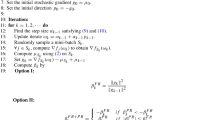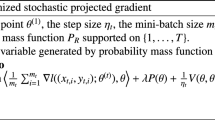Abstract
Huber robust regression (HRR) has attracted much attention in machine learning due to its greater robustness to outliers compared to least-squares regression. However, existing algorithms for HRR are computationally much less efficient than those for least-squares regression. Based on a maximally split alternating direction method of multipliers (MS-ADMM) for model fitting, a highly computationally efficient algorithm referred to as the modified MS-ADMM is derived in this article for HRR. After analyzing the convergence of the modified MS-ADMM, a parameter selection scheme is presented for the algorithm. With the parameter values calculated via this scheme, the modified MS-ADMM converges very rapidly, much faster than several typical HRR algorithms. Through applications in the training of stochastic neural networks and comparisons with existing algorithms, the modified MS-ADMM is shown to be computationally much more efficient than the convex quadratic programming method, the Newton method, the iterative reweighted least-squares method, and Nesterov’s accelerated gradient method. Implementation of the proposed algorithm on a GPU-based parallel computing platform demonstrates its higher GPU acceleration ratio compared to the competing methods and, thus, its greater superiority in computational efficiency over the competing methods.













Similar content being viewed by others
Explore related subjects
Discover the latest articles, news and stories from top researchers in related subjects.Data Availability
All the data used in this article are sourced from open and publicly accessible platforms. No proprietary, confidential, or private data has been used.
References
Huber PJ (1981) Robust Statistics. John Wiley & Sons, New York
Li W, Swetits JJ (1998) The linear 1 estimator and the Huber M-estimator. SIAM J Optim 8(2):457–475
Chen B, Pinar MC (1998) On Newton’s method for Huber’s robust M-estimation problems in linear regression. BIT Numer Math 38(4):674–684
Mangasarian OL, Musicant DR (2000) Robust linear and support vector regression. IEEE Trans Pattern Anal Mach Intell 22(9):950–955
Zhu J, Hoi SCH, Lyu MR-T (2008) Robust regularized kernel regression. IEEE Trans Syst Man Cybern Part B: Cybern 38(6):1639–1644
Zhang K, Luo M (2015) Outlier-robust extreme learning machine for regression problems. Neurocomputing 151(3):1519–1527
Huang D, Cabral R, De la Torre F (2016) Robust regression. IEEE Trans Pattern Anal Mach Intell 38(2):363–375
Barreto GA, Barros ALBP (2016) A robust extreme learning machine for pattern classification with outliers. Neurocomputing 176:3–13
Chen K, Lv Q, Lu Y, Dou Y (2017) Robust regularized extreme learning machine for regression using iteratively reweighted least squares. Neurocomputing 230:345–358
Chen B, Wang X, Lu N, Wang S, Cao J (2018) Mixture correntropy for robust learning. Pattern Recogn 79:318–327
Jin J-W, Chen CLP (2018) Regularized robust broad learning system for uncertain data modeling. Neurocomputing 322:58–69
Zoubir AM, Koivunen V, Ollila E et al. (2018) Robust Statistics for Signal Processing, Cambridge University Press
Barron JT (2019) A general and adaptive robust loss function, in Proceedings of the IEEE/CVF Conference on Computer Vision and Pattern Recognition (CVPR), 4331–4339
Yang L, Dong H (2019) Robust support vector machine with generalized quantile loss for classification and regression. Appl Soft Comput 81:105483
Xie S, Yang C, Yuan X, Wang X, Xie Y (2019) A novel robust data reconciliation method for industrial processes. Control Eng Pract 83:203–212
Balasundaram S, Prasad SC (2020) Robust twin support vector regression based on Huber loss function. Neural Comput Appl 32:11285–11309
Chu F, Liang T, Chen CLP, Wang X, Ma X (2020) Weighted broad learning system and its application in nonlinear industrial process modeling. IEEE Trans Neural Netw Learn Syst 31(8):3017–3031
da Silva BLS, Inaba FK, Salles EOT, Ciarelli PM (2020) Outlier robust extreme machine learning for multi-target regression, Expert Systems With Applications, vol. 140, Article 112877, 1–13
Khan DM, Ali M, Ahmad Z, Manzoor S, Hussain S (2021) A new efficient redescending M-estimator for robust fitting of linear regression models in the presence of outliers, Mathematical Problems in Engineering, vol. 2021, Article 3090537, 1–11
Dong H, Yang L (2021) Kernel-based regression via a novel robust loss function and iteratively reweighted least squares. Knowl Inform Syst 63(5):1149–1172
Sabzekar M, Hasheminejad SMH (2021) Robust regression using support vector regressions, Chaos, Solitons & Fractals, vol. 144, Article 110738
Zheng Y, Wang S, Chen B (2023) Quantized minimum error entropy with fiducial points for robust regression. Neural Netw 168:405–418
Liu L, Liu T, Chen CLP, Wang Y (2023) Modal-regression-based broad learning system for robust regression and classification. IEEE Trans Neural Netw Learn Syst (Early Access). (https://doi.org/10.1109/TNNLS.2023.3256999)
Zheng Y, Wang S, Chen B (2023) Robust one-class classification with support vector data description and mixed exponential loss function. Eng Appl Artif Intell 122:106153
Boyd S, Parikh N, Chu E, Peleato B, Eckstein J (2011) Distributed optimization and statistical learning via the alternating direction method of multipliers, Foundations and Trends® in Machine Learning, 3:(1) 1–122
Luo M, Zhang L, Liu J, Guo J, Zheng Q (2017) Distributed extreme learning machine with alternating direction method of multiplier. Neurocomputing 261:164–170
Wang H, Gao Y, Shi Y, Wang R (2017) Group-based alternating direction method of multipliers for distributed linear classification. IEEE Trans Cybern 47(11):3568–3582
Wang H, Feng R, Han Z-F, Leung C-S (2018) ADMM-based algorithm for training fault tolerant RBF networks and selecting centers. IEEE Trans Neural Netw Learn Syst 29(8):3870–3878
Inaba FK, Salles EOT, Perron S, Caporossi G (2018) DGR-ELMDistributed generalized regularized ELM for classification. Neurocomputing 275:1522–1530
Kim B, Yu D, Won JH (2018) Comparative study of computational algorithms for the Lasso with high-dimensional, highly correlated data. Appl Intell 48(8):1933–1952
Lai X, Cao J, Huang X, Wang T, Lin Z (2020) A maximally split and relaxed ADMM for regularized extreme learning machines. IEEE Trans Neural Netw Learn Syst 31(6):1899–1913
Wang Y, Guan Y, Wang B, Li X (2022) Learning with partial multi-labeled data by leveraging low-rank constraint and decomposition. Applied Intelligence, Online, pp 1–13
Hu J, Guo T, Zhao T (2022) A faster stochastic alternating direction method for large scale convex composite problems. Applied Intelligence, Online, pp 1–13
Lai X, Cao J, Lin Z (2023) An accelerated maximally split ADMM for a class of generalized ridge regression. IEEE Trans Neural Netw Learn Syst 34(2):958–972
Bernier JL, Ortega J, Rodriguez MM, Rojas I, Prieto A (1999) An accurate measure for multilayer perceptron tolerance to weight deviations. Neural Process Lett 10(2):121–130
Sum JP-F, Leung C-S, Ho KI-J (2009) On objective function, regularizer, and prediction error of a learning algorithm for dealing with multiplicative weight noise. IEEE Trans Neural Netw 20(1):124–138
Han Z-F, Feng R-B, Wan WY, Leung C-S (2015) Online training and its convergence for faulty networks with multiplicative weight noise. Neurocomputing 155:53–61
Feng R-B, Han Z-F, Wan WY, Leung C-S (2017) Properties and learning algorithms for faulty RBF networks with coexistence of weight and node failures. Neurocomputing 224:166–176
Boyd S, Vandenberghe L (2009) Convex Optimization. Cambridge University Press, Cambridge
Y. Nesterov, Introductory Lectures on Convex Optimization: A Basic Course, ser. Applied Optimization, vol. 87, Norwell, MA: Kluwer, 2004.
Cevher V, Becker S, Schmidt M (May2014) Convex optimization for big data: scalable, randomized, and parallel algorithms for big data analytics. IEEE Signal Process Mag 31(5):32–43
Huang G-B, Zhou H, Ding X, Zhang R (2012) Extreme learning machine for regression and multiclass classification. IEEE Transactions on Systems, Man, and Cybernetics - Part B: Cybernetics 42(2):513–529
Chen CLP, Liu Z, Feng S (2018) Broad Learning System: An effective and efficient incremental learning system without the need for deep architecture. IEEE Trans Neural Netw Learn Syst 29(1):10–24
Acknowledgements
This work was supported by the Natural Science Foundation of Zhejiang Province (LZ22F030002, LZ24F030010), the National Natural Science Foundation of China (U1909209), the National Key Research Program of China (2021YFE0100100), and the Research Funding of Education of Zhejiang Province (Y202249784).
Author information
Authors and Affiliations
Contributions
Tianlei Wang: Conceptualization, Investigation, Writing—review and editing. Xiaoping Lai: Conceptualization, Methodology, Software, Investigation, Writing—original draft preparation. Jiuwen Cao: Conceptualization, Investigation, Writing—review and editing, Supervision.
Corresponding author
Ethics declarations
Competing Interests
All authors declare that they have no conflicts of interest.
Ethical Compliance
This study does not involve any human participant or animal.
Additional information
Publisher's Note
Springer Nature remains neutral with regard to jurisdictional claims in published maps and institutional affiliations.
Rights and permissions
Springer Nature or its licensor (e.g. a society or other partner) holds exclusive rights to this article under a publishing agreement with the author(s) or other rightsholder(s); author self-archiving of the accepted manuscript version of this article is solely governed by the terms of such publishing agreement and applicable law.
About this article
Cite this article
Wang, T., Lai, X. & Cao, J. A highly efficient ADMM-based algorithm for outlier-robust regression with Huber loss. Appl Intell 54, 5147–5166 (2024). https://doi.org/10.1007/s10489-024-05370-9
Accepted:
Published:
Issue Date:
DOI: https://doi.org/10.1007/s10489-024-05370-9




